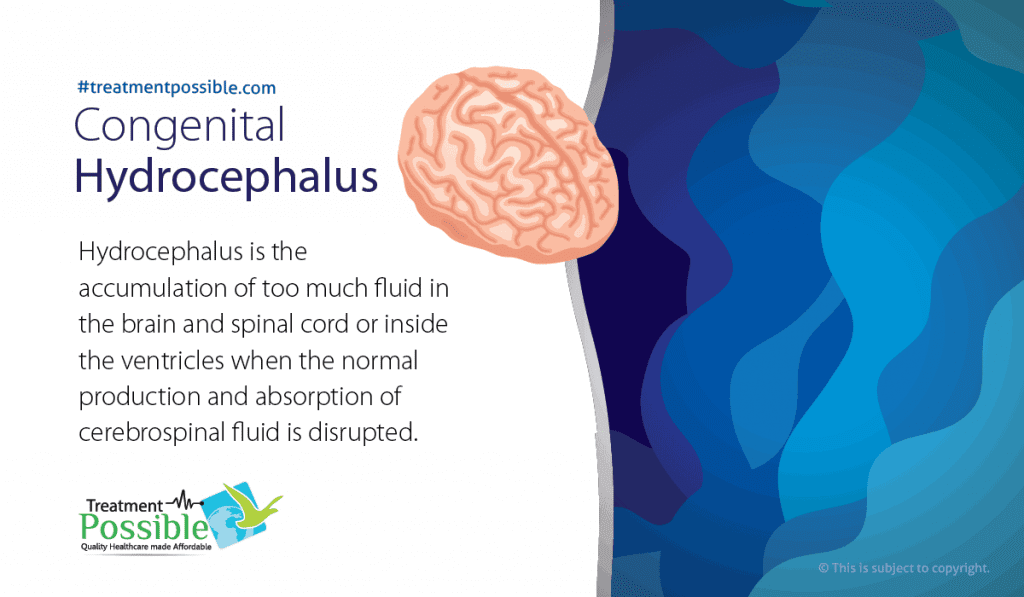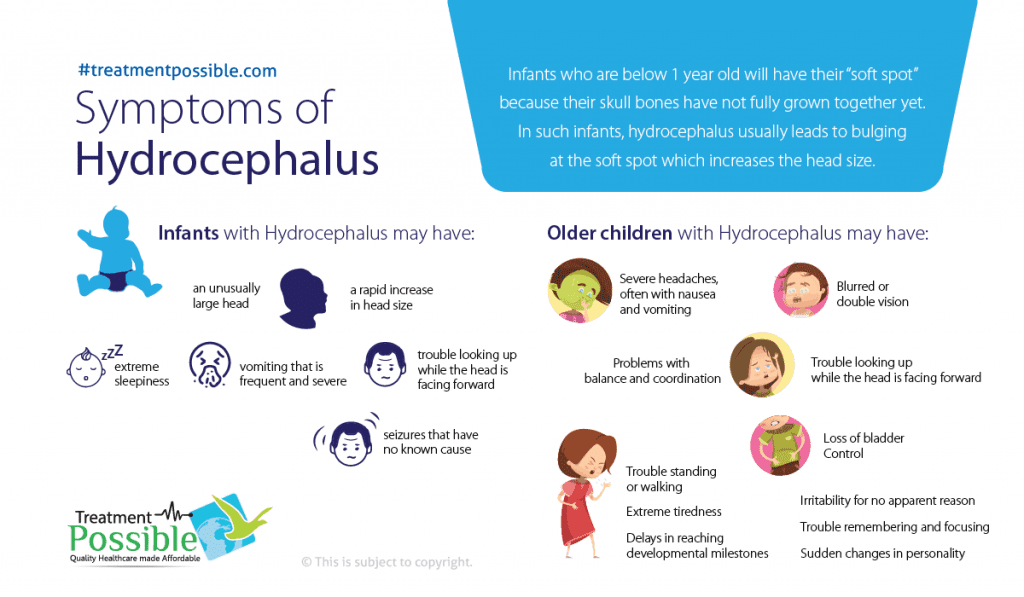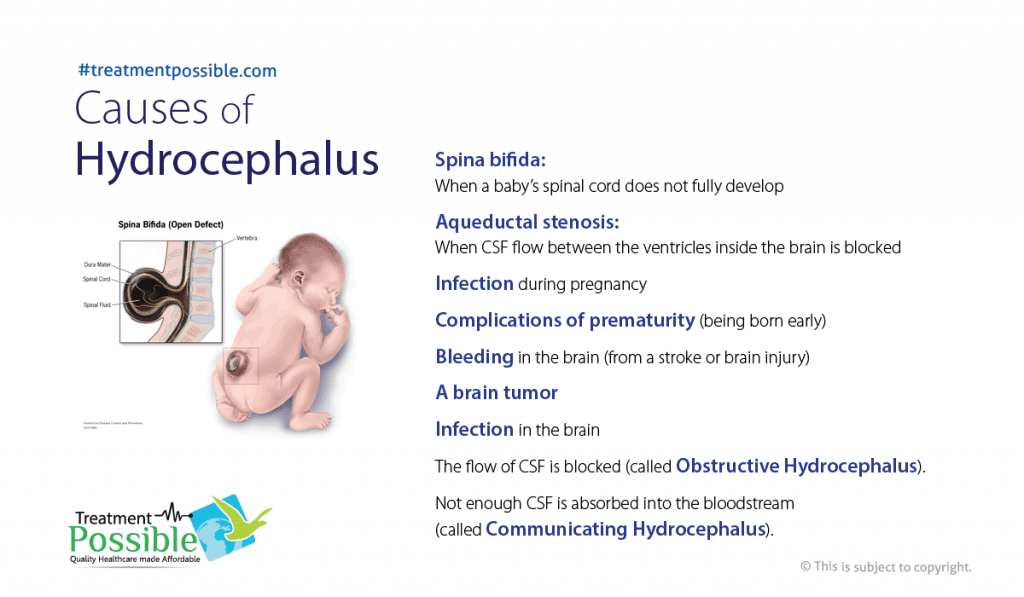Hydrocephalus Surgery
What Is Hydrocephalus in Children?
Hydrocephalus in children is the accumulation of too much fluid in the brain and spinal cord. Hydrocephalus is derived from the Greek word “hydro,” means “water,” and “cephalus,” means “head.”
What is Congenital Hydrocephalus?
Cerebrospinal fluid flows through the ventricles, which are open areas within the brain, by way of channels that connect one ventricle to another. Eventually, the fluid is absorbed into the bloodstream.
To maintain normal pressure inside the skull the production, flow and absorption of cerebrospinal fluid should be kept in balance.
Most problems arise from obstruction of cerebrospinal fluid flow or poor absorption. Hydrocephalus is the accumulation of too much cerebrospinal fluid inside the ventricles when the normal production and absorption of cerebrospinal fluid is disrupted.

What are the Symptoms of Hydrocephalus?
Symptoms of hydrocephalus can vary depending on your child’s age and how advanced the condition is when it is discovered.
Infants with hydrocephalus may have:
- an unusually large head
- a rapid increase in head size
- extreme sleepiness
- vomiting that is frequent and severe
- trouble looking up while the head is facing forward
- seizures that have no known cause
Older children with hydrocephalus may have:
- severe headaches, often with nausea and vomiting
- blurred or double vision
- problems with balance
- trouble looking up while the head is facing forward
- problems with coordination
- trouble standing or walking
- loss of bladder control
- extreme tiredness
- irritability for no apparent reason
- delays in reaching developmental milestones
- trouble remembering and focusing
- sudden changes in personality
Infants who are below 1 year old will have their “soft spot” because their skull bones have not fully grown together yet. In such infants, hydrocephalus usually leads to bulging at the soft spot which increases the head size.

What Causes Hydrocephalus?
Cerebrospinal fluid is saltwater that’s made inside the ventricles. It flows around the brain and spinal cord, cushioning them. It also sends nutrients to the brain and disposes of the waste, then it is absorbed into the bloodstream, and new, fresh CSF takes its place. The causes may be linked to a genetic defect or a complication of another disorder, such as spina bifida or encephaloceles.
Children can also develop hydrocephalus after birth as a complication of:
- premature birth
- intraventricular hemorrhage
- subarachnoid hemorrhage
- meningitis
- a brain tumor or lesion
- a spinal cord injury or spinal cord tumor
- traumatic head injury
The Causes of hydrocephalus include:
- Spina bifida: when a baby’s spinal cord does not fully develop
- Aqueductal stenosis: when CSF flow between the ventricles inside the brain is blocked
- Infection during pregnancy
- Complications of prematurity (being born early)
- Bleeding in the brain (from a stroke or brain injury)
- A brain tumor
- Infection in the brain
- The flow of CSF is blocked (called obstructive hydrocephalus).
- Not enough CSF is absorbed into the bloodstream (called communicating hydrocephalus).

What is the Risk Factors of Hydrocephalus?
A child can:
- be born with hydrocephalus (called congenital hydrocephalus)
- get it later (called acquired hydrocephalus)
Hydrocephalus can run in families.
How Is Hydrocephalus Diagnosed?
Doctors diagnose hydrocephalus by:
- Asking about symptoms
- Doing an examination
- Doing imaging studies such as an ultrasound, CT scan, or MRI
Treatment of Hydrocephalus:
A team approach, including practitioners from multiple specialties, is best for deciding on a course of treatment for the child with hydrocephalus. Neurosurgeons, neurologists, pediatric ophthalmologists, radiologists and others may be called upon to develop the treatment plan.
In most cases, hydrocephalus can be treated, but your child may require ongoing monitoring throughout his or her life. Follow-up care is extremely important to track the progress of your child’s recovery.
1. VP Shunt Surgery for Hydrocephalus:
This is the most common surgical procedure for hydrocephalus. VP shunt placement is a small piece of silicone tubing placed surgically inside the body to bypass a blockage or create a better flow of cerebrospinal fluid.
VP shunting allows fluid to flow through it in one direction. A valve system regulates the flow and creates a reservoir of cerebrospinal fluid that can be tested often to make sure the shunt is working properly and there are no signs of infection.
2. Endoscopic Third Ventriculostomy:
Certain types of hydrocephalus in selected patients can be treated by an alternative to shunting. Endoscopic third ventriculostomy is a surgical procedure and the surgeon uses an endoscopic approach and makes a tiny hole in the affected ventricle to bypass the blockage and restore a normal flow of cerebrospinal fluid.
3. Other treatments:
Some people with hydrocephalus especially children need additional treatment, depending on the severity of long-term complications of hydrocephalus. A care team for children may include:
- Pediatrician or physiatrist oversees the treatment plan and medical care
- A pediatric neurologist specializes in the diagnosis and treatment of neurological disorders in children
- Occupational therapist specializes in therapy to develop everyday skills
- Developmental therapist specializes in therapy to help your child develop age-appropriate behaviors, social skills and interpersonal skills
- Mental health provider could be a psychologist or psychiatrist
- Social worker, to access services and planning for transitions in care
- Special education teacher addresses the learning disabilities, determines educational needs and identifies appropriate educational resources
Want more clarification about medical expense & treatment plan?
Consult an Experienced Doctor online for free and Plan for hydrocephalus Surgery In India
What are the Complications of Hydrocephalus Surgeries?
Both surgical procedures can result in complications. Shunt systems will stop draining cerebrospinal fluid, because of mechanical malfunctions, blockage or infections. Complications of ventriculostomy include bleeding and infections.
Any failure requires prompt attention, surgical revisions or other interventions. Signs and symptoms of problems may include:
- Fever
- Irritability
- Drowsiness
- Nausea or vomiting
- Headache
- Vision problems
- Redness, pain or tenderness of the skin along the path of the shunt tube
- Abdominal pain while the shunt valve is in the abdomen
- Recurrence of the hydrocephalus symptoms
How can Parents help in the treatment for their Child?
Your child needs your care and support. Treatment for hydrocephalus is successful in many children. But most will need more than one surgery and ongoing medical care.
To help your child get the best treatment:
- Follow all medical recommendations, such as taking prescribed medicines.
- If needed, take your child to:
- early intervention programs
- physical therapy
- occupational therapy
Care at Treatment Possible:
Treatment Possible is associated with the Best Neurosurgeon for hydrocephalus who are experienced in operating complex cases and ensure the highest success rate. We only work with Best Hospital for hydrocephalus.
Our understanding of the Indian Healthcare market and our valued relation with Best Hospital for hydrocephalus enables us to maintain the cost that are reasonable, affordable and transparent. Hydrocephalus Surgery Cost in India through Treatment Possible can be 10-20% lower than similar companies in India and 50-60% cheaper than in other countries.
You can also send your medical reports for hydrocephalus to care@treatmentpossible.com for free opinions and suggestions from The Best Neurosurgeon for Hydrocephalus with the hassle-free setup of post-operative recovery care, medical travel & stay during the Medical treatment. No matter what the health condition, you always get good healthcare options and cost advantage from Treatment Possible.
